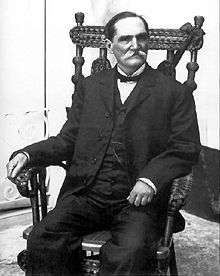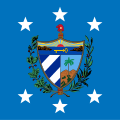Tomás Estrada Palma
| Tomás Estrada Palma | |
|---|---|
 | |
| President of Cuba | |
|
In office 20 May 1902 – 28 September 1906 | |
| Vice President | Luis Estévez Romero and Domingo Méndez Capote |
| Preceded by | None |
| Succeeded by | José Miguel Gómez |
| Personal details | |
| Born |
Tomás Estrada Palma July 9, 1835 Bayamo, Spanish Cuba |
| Died |
November 4, 1908 (aged 73) Santiago de Cuba, Cuba |
| Nationality |
|
| Political party |
Cuban Revolutionary Party (1892–1902) Republican Party of Havana (1902–1906) |
| Spouse(s) | Genoveva Guardiola Arbizu |
| Children | Jose M. Estrada-Palma Guardiola |
| Occupation | Attorney |
Tomás Estrada Palma (July 9, 1835, Bayamo – November 4, 1908, Santiago de Cuba) was a Cuban political figure. He served as the first President of Cuba between 1902 and 1906.
Fight for independence
Tomás Estrada Palma was a president of the Cuban Republic in Arms during the Ten Years' War.
Estrada Palma was captured by Spanish troops and sent into exile. While in exile, he traveled to New York where he worked with José Martí.
After Martí's death, Estrada Palma became the new leader of the Cuban Revolutionary Party.
When the revolutionaries established a Government in arms, Estrada Palma was sent to Washington as its diplomat. With the help of an American banker, he tried offering Spain $150 million to give up the island, a plan that failed.
He was, however, successful in getting the US Congress to pass the Joint Resolution. This bill was one of the factors that led the United States to declare war on Spain, demanding that Cuba be freed from Spanish colonial rule. (see Spanish–American War)
First term
After a few years of General Leonard Wood's rule in Cuba, elections were to be held. The Republican Liberals, headed by José Miguel Gómez, and the National Liberals, headed by Alfredo Zayas, both supported Estrada Palma. He did not campaign though, staying the full-time in the U.S., where he was a citizen.
Palma's opponent, General Bartolomé Masó withdrew his candidacy in protest against favoritism by the occupational government and the manipulation of the political machine by Estada Palma's followers. Thus Estrada Palma was left as the only candidate.[1] On December 31, 1901, Estrada Palma was elected President. His politics have been likened to those of U.S. President Theodore Roosevelt.
American troops left after the Cuban government signed a bill lowering tariffs on American products and incorporated the Platt Amendment into their constitution. Many American companies came to do business in Cuba.
On February 16, 1903, Estrada Palma signed the Cuban-American Treaty of Relations, agreeing to lease the Guantanamo Bay area to the United States, in perpetuity, for use as a naval base and coaling station. This was a minor victory for the Estrada Palma administration for Washington had wanted five naval bases in the island. It is a testament to his diplomatic skills that Estada Palma was able to obtain the reduction even with American troops stationed in the island. His policies were also responsible for improvements in education, communications and public health which had suffered from the devastation created by the war of independence from Spain.
Second term
Estrada Palma was re-elected unopposed in 1905, but this time against violent opposition by the liberals, who claimed electoral fraud. Estrada Palma and the moderate camp appealed to the US for intervention, and in 1906 the US began the Second Occupation of Cuba and installed a provisional occupation government which lasted from 1906 to 1909. Another pro-American government was established in Cuba under Charles Magoon.[2]
Personal life
Born in Bayamo, Cuba, Estrada Palma was the son of Andrés Duque de Estrada y Palma and wife and cousin María Candelaria de Palma y Tamayo. He married on May 15, 1881 in Honduras with Genoveva Guardiola Arbizu (1854–1926), daughter of General José Santos Guardiola, President of Honduras, and wife Ana de Arbizu, and they had six children: Manuel José Estrada Palma Guardiola (b. 1875); Tomás Andrés Estrada Palma Guardiola (1884–1960), married in 1910 to Helen Douglas Browne and had issue; Carlos Joaquín Estrada Palma Guardiola; María de la Candelaria Estrada Palma Guardiola (b. 1887); Mariana de la Luz Estrada Palma Guardiola; and Rafael Morales Estrada Palma Guardiola. He was an attorney, and died in Santiago de Cuba.
Continuation of the Name
Tomás Andrés Estrada-Palma Guardiola and Helen Douglas Browne continued the name, Tomás Estrada Palma, with their first-born child, Tomás Douglas Estrada-Palma III, born on May 12, 1911 in New York. Tomás Douglas Estrada-Palma III and Alyce Mae Carroll married and continued the name with their first-born child, Tomás Ramón Estrada-Palma IV, born in Miami, Florida and who currently resides in Edgewater, MD. They also had three more children, Patrick Carroll Estrada-Palma, Candita Margaret Estrada-Palma, and Kathleen Riordan Estrada-Palma. The name stops with Tomás Ramón Estrada-Palma IV since he decided to not continue this name with his children.
Honours
A statue of Estrada Palma was erected in the "Avenida de los Presidentes" in Havana. It was pulled down by Fidel Castro's revolutionaries, reportedly because they blamed Estrada Palma for starting the trend of U.S. intervention in Cuba. The plinth, with a pair of shoes, remains.
Palma spent many years of his U.S. exile in the Town of Woodbury, in Orange County, New York. Along a road that now bears his name (Estrada Road, in the hamlet of Central Valley), he ran a summer camp which has since been abandoned.
Notes
- ↑ Navarro, José Cantón: History of Cuba, Editorial SI-MAR, Havana, Cuba, 1998, p. 81, ISBN 959-7054-19-1
- ↑ Charles Magoon at library.thinkquest.org
References
- Mellander, Gustavo A. (1971). The United States in Panamanian Politics: The Intriguing Formative Years. Daville,Ill.:Interstate Publishers. OCLC 138568.
- Mellander, Gustavo A.; Nelly Maldonado Mellander (1999). Charles Edward Magoon: The Panama Years. Río Piedras, Puerto Rico: Editorial Plaza Mayor. ISBN 1-56328-155-4. OCLC 42970390.
- Otero, Juan Joaquin (1954). Libro De Cuba, Una Enciclopedia Ilustrada Que Abarca Las Artes, Las Letras, Las Ciencias, La Economia, La Politica, La Historia, La Docencia, Y ElProgreso General De La Nacion Cubana - Edicion Conmemorative del Cincuentenario de la Republica de Cuba, 1902-1952. (Spanish)
External links
| Wikimedia Commons has media related to Tomás Estrada Palma. |
- Digital Images from the Tomás Estrada Palma Collection held by the Cuban Heritage Collection of the University of Miami Libraries
| Political offices | ||
|---|---|---|
| Preceded by None |
President of Cuba 1902–1906 |
Succeeded by José Miguel Gómez |
